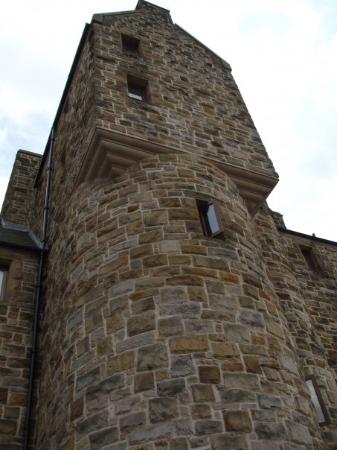This is the Radisson BLU Hotel Edinburgh, on the famous Royal Mile in the middle of the city. It was designed by the Scottish architect Ian Begg, who has restored and built many beautiful buildings in Scotland. This hotel, which according to scottish-places.info filled anotorious gap site, was completed in 1990! It's a very traditional building, designed in a sort of local vernacular style, but it's not made to look old by applying fake ageing techniques or anything of the sort.
On the side of the main entrance, there is a plaque, inscribed with the words "AL THIS WARK WAS BEGUN DANCON ON 10-JANUARY-1989 AN ENDIT BE THEM ON 31-MARCH-1990", leaving no doubt as to the building's age. There's another plaque at the foot of the tower (covered up in the top picture, but normally visible), clearly stating the year the hotel was built "AD 1989". I did not get to see much of the interiors, but I did pay a visit to their elegant lobby, in which I found friendly staff, who unfortunately were not able to tell me the name of the architect. In my opinion, they should be informing their guests about this very special building and the architect behind it.
Ian Begg has a passion for everything Scottish, and is the architect behind many new buildings in this and related styles. On his excellent website you can read more about his work, and even see an excerpt from a series of BBC programmes on "The Scottish House" from the early 1970s (which, by the way, should be published online, on Youtube or elsewhere). An excerpt:
This very sincere and talented man is also the architect of another beautiful urban Scottish building, St. Mungo Museum of Religious Life and Art, in Glasgow.
 |
| Photo courtesy of visitscotland.com |
Constructed in 1993, the building blends in with its surroundings while still retaining a character of its own. The design is intended to reflect the now lost medieval Glasgow Castle, which formerly occupied the site, but sadly was torn down at the end of the eighteenth century. Apart from exhibitions on religious life in Scotland, the building also features a Zen garden, a courtyard used for markets, festivals concerts, as well as stain More pictures of the exteriors, interiors and even a model of the building can seen at Undiscovered Scotland.
 |
| Zen garden |
 | |
|
 |
| The courtyard during Merchant City Festival |

This photo of St. Mungo Museum of Religious Life and Art is courtesy of TripAdvisor
Discovering the work of Mr Begg has certainly motivated me to make more trips to Scotland, and learn more about this interesting designer and his thoughts on architecture. Wish me luck!





Its Amazing blog which is giving a fantastic knowledge. It is helps us. please post more related blogs.
ReplyDeleteVisit :- Scottish hotels – schottische Hotels